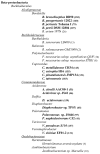The complete genome sequence of Cupriavidus metallidurans strain CH34, a master survivalist in harsh and anthropogenic environments
- PMID: 20463976
- PMCID: PMC2864759
- DOI: 10.1371/journal.pone.0010433
The complete genome sequence of Cupriavidus metallidurans strain CH34, a master survivalist in harsh and anthropogenic environments
Abstract
Many bacteria in the environment have adapted to the presence of toxic heavy metals. Over the last 30 years, this heavy metal tolerance was the subject of extensive research. The bacterium Cupriavidus metallidurans strain CH34, originally isolated by us in 1976 from a metal processing factory, is considered a major model organism in this field because it withstands milli-molar range concentrations of over 20 different heavy metal ions. This tolerance is mostly achieved by rapid ion efflux but also by metal-complexation and -reduction. We present here the full genome sequence of strain CH34 and the manual annotation of all its genes. The genome of C. metallidurans CH34 is composed of two large circular chromosomes CHR1 and CHR2 of, respectively, 3,928,089 bp and 2,580,084 bp, and two megaplasmids pMOL28 and pMOL30 of, respectively, 171,459 bp and 233,720 bp in size. At least 25 loci for heavy-metal resistance (HMR) are distributed over the four replicons. Approximately 67% of the 6,717 coding sequences (CDSs) present in the CH34 genome could be assigned a putative function, and 9.1% (611 genes) appear to be unique to this strain. One out of five proteins is associated with either transport or transcription while the relay of environmental stimuli is governed by more than 600 signal transduction systems. The CH34 genome is most similar to the genomes of other Cupriavidus strains by correspondence between the respective CHR1 replicons but also displays similarity to the genomes of more distantly related species as a result of gene transfer and through the presence of large genomic islands. The presence of at least 57 IS elements and 19 transposons and the ability to take in and express foreign genes indicates a very dynamic and complex genome shaped by evolutionary forces. The genome data show that C. metallidurans CH34 is particularly well equipped to live in extreme conditions and anthropogenic environments that are rich in metals.
Conflict of interest statement
Figures






Similar articles
-
Plasmids pMOL28 and pMOL30 of Cupriavidus metallidurans are specialized in the maximal viable response to heavy metals.J Bacteriol. 2007 Oct;189(20):7417-25. doi: 10.1128/JB.00375-07. Epub 2007 Aug 3. J Bacteriol. 2007. PMID: 17675385 Free PMC article.
-
New mobile genetic elements in Cupriavidus metallidurans CH34, their possible roles and occurrence in other bacteria.Antonie Van Leeuwenhoek. 2009 Aug;96(2):205-26. doi: 10.1007/s10482-009-9345-4. Epub 2009 Apr 24. Antonie Van Leeuwenhoek. 2009. PMID: 19390985
-
Variation in genomic islands contribute to genome plasticity in Cupriavidus metallidurans.BMC Genomics. 2012 Mar 23;13:111. doi: 10.1186/1471-2164-13-111. BMC Genomics. 2012. PMID: 22443515 Free PMC article.
-
Cupriavidus metallidurans: evolution of a metal-resistant bacterium.Antonie Van Leeuwenhoek. 2009 Aug;96(2):115-39. doi: 10.1007/s10482-008-9284-5. Epub 2008 Oct 1. Antonie Van Leeuwenhoek. 2009. PMID: 18830684 Review.
-
Ralstonia metallidurans, a bacterium specifically adapted to toxic metals: towards a catalogue of metal-responsive genes.FEMS Microbiol Rev. 2003 Jun;27(2-3):385-410. doi: 10.1016/S0168-6445(03)00045-7. FEMS Microbiol Rev. 2003. PMID: 12829276 Review.
Cited by
-
Rhizosphere colonization and arsenic translocation in sunflower (Helianthus annuus L.) by arsenate reducing Alcaligenes sp. strain Dhal-L.World J Microbiol Biotechnol. 2013 Oct;29(10):1931-40. doi: 10.1007/s11274-013-1359-4. Epub 2013 Apr 30. World J Microbiol Biotechnol. 2013. PMID: 23632906
-
Characterization of the survival ability of Cupriavidus metallidurans and Ralstonia pickettii from space-related environments.Microb Ecol. 2013 Feb;65(2):347-60. doi: 10.1007/s00248-012-0139-2. Epub 2012 Dec 5. Microb Ecol. 2013. PMID: 23212653
-
Genomic and physiological characterization of Novosphingobium terrae sp. nov., an alphaproteobacterium isolated from Cerrado soil containing a mega-sized chromid.Braz J Microbiol. 2023 Mar;54(1):239-258. doi: 10.1007/s42770-022-00900-4. Epub 2023 Jan 26. Braz J Microbiol. 2023. PMID: 36701110 Free PMC article.
-
Soil Nutrients Drive Function and Composition of phoC-Harboring Bacterial Community in Acidic Soils of Southern China.Front Microbiol. 2019 Nov 20;10:2654. doi: 10.3389/fmicb.2019.02654. eCollection 2019. Front Microbiol. 2019. PMID: 31824452 Free PMC article.
-
Combining sequencing approaches to fully resolve a carbapenemase-encoding megaplasmid in a Pseudomonas shirazica clinical strain.Emerg Microbes Infect. 2019;8(1):1186-1194. doi: 10.1080/22221751.2019.1648182. Emerg Microbes Infect. 2019. PMID: 31381486 Free PMC article.
References
-
- Fergusson JE. Oxford, UK: Pergamon Press; 1990. The Heavy Elements: Chemistry, Environmental Impact, and Health Effects.
-
- Adriano DC. New-York, US: Springer-Verlag; 2001. Trace Elements in Terrestrial Environments: Biogeochemistry, Bioavailability, and Risks of Metals.
-
- Mergeay M, Houba C, Gerits J. Extrachromosomal inheritance controlling resistance to cadmium, cobalt, copper and zinc ions: evidence from curing in a Pseudomonas [proceedings]. Arch Int Physiol Biochim. 1978;86:440–442. - PubMed
-
- Diels L, Faelen M, Mergeay M, Nies D. Mercury transposons from plasmids governing multiple resistance to heavy metals in Alcaligenes eutrophus CH34. Arch Intern Physiol Bioch. 1985;93:27–28.
-
- Juhnke S, Peitzsch N, Hubener N, Grosse C, Nies DH. New genes involved in chromate resistance in Ralstonia metallidurans strain CH34. Arch Microbiol. 2002;179:15–25. - PubMed
Publication types
MeSH terms
Substances
LinkOut - more resources
Full Text Sources
Molecular Biology Databases

